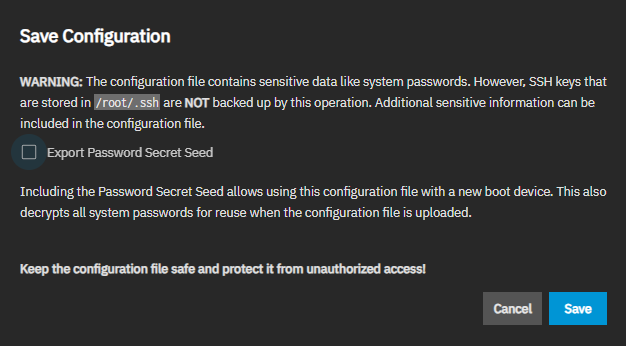Backing Up TrueNAS
7 minute read.
After configuring your TrueNAS storage and data sharing or any other function, service, or application, it is time to ensure an effective data backup.
You should also:
- Download and save your system configuration file to protect your system configuration information.
- Download a debug file.
- Create a boot environment to use as a restore point.
- Backup Stored Data
TrueNAS provides several options to set up a data storage backup method, including using a cloud sync provider and a scheduled task or configuring a replication task.
After setting up TrueNAS, first, back up your system configuration by downloading the system configuration file.
In TrueNAS 25.04 (and later), users must log in as a system administrator with full administrative access to upload or download a system configuration file. Other users, including restricted admin accounts such as a shares administrator, cannot perform database operations. See Using Administrator Logins for more information on admin account types.
When downloading the configuration (config) file, select the Export Password Secret Seed option to include the secret seed in the config file. Downloading the config file allows you to restore the system to a different operating system device where the secret seed is not already present.
Physically secure the config file with the secret seed, and any encryption key files to decrypt encrypted datasets or pools.
We recommend backing up the system configuration regularly. Doing so preserves settings when migrating, restoring, or fixing the system if it runs into any issues. Save the configuration file each time the system configuration changes.
To download the configuration file:
Go to System > General Settings and click on Manage Configuration. Select Download File.
The Save Configuration dialog opens.
Select Export Password Secret Seed and then click Save. The system downloads the system configuration. Keep this file in a safe location on your network where files are regularly backed up.
After saving the system configuration, save an initial system debug file by going to System > Advanced Settings and clicking Save Debug. After the download completes, save this initial debug file with your system configuration file.
Why download the initial system debug file? Downloading and storing the initial system debug after completing the system configuration is a recommended best practice to have a point of reference for your system if a problem arises. Save a debug file after a major system upgrade or reconfiguration to provide Support or Engineering if requested.
After installing and completing your system configuration, create a boot environment to use as a restore point.
If you lose access to the TrueNAS UI, you can establish an SSH session and restore it from the boot environment. You can clone the boot environment listed after the initial-install environment and rename the clone to something you recognize, such as the release number with date and time.
TrueNAS has several options that allow you to back up data:
TrueCloud backup and cloud sync tasks require setting up a cloud service provider account and adding the credentials in TrueNAS before configuring and scheduling the tasks.
Replication requires setting up SSH credentials before configuring and scheduling the task. Rsync tasks can be configured with SSH credentials or set to use a module.
Cloud sync requires an account with a cloud storage provider and a storage location created with that provider, like an Amazon S3 bucket. TrueNAS supports major providers like Storj, Amazon S3, Google Cloud, Box, and Microsoft Azure, along with a variety of other vendors. These providers can charge fees for data transfer and storage, so please review the policies of your cloud storage provider before transferring your data.
Cloud sync and TrueCloud backup tasks can be configured to send, receive, or synchronize data with a cloud storage provider.
The simplest way to set up a TrueCloud backup task is using a Storj iX account. See Managing TrueCloud Backup Tasks for a full tutorial.
See Adding Cloud Credentials for information on connecting TrueNAS to other cloud storage providers.
Replication takes a moment-in-time snapshot of data and then copies that snapshot to another location. Snapshot technology typically uses less storage than full file backups and has more management and snapshot storage options.
You can monitor created backup tasks from the Dashboard widget.





